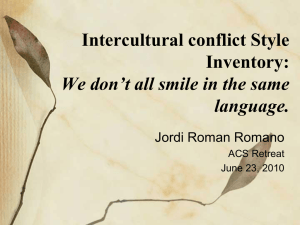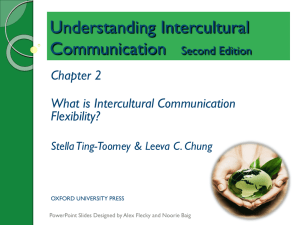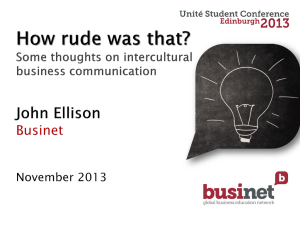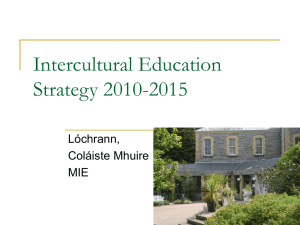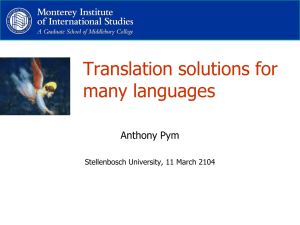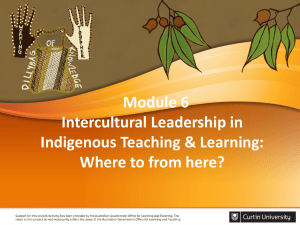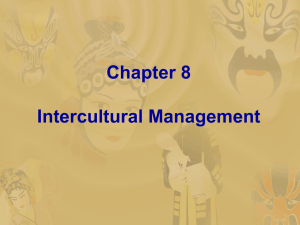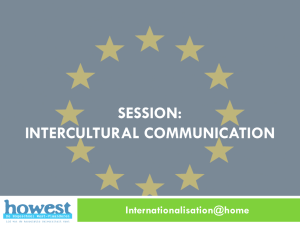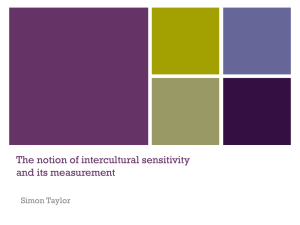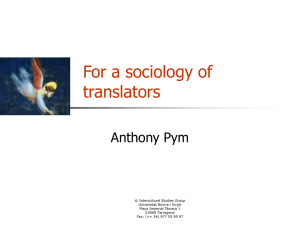Intercultural communication studies: the policy background
advertisement
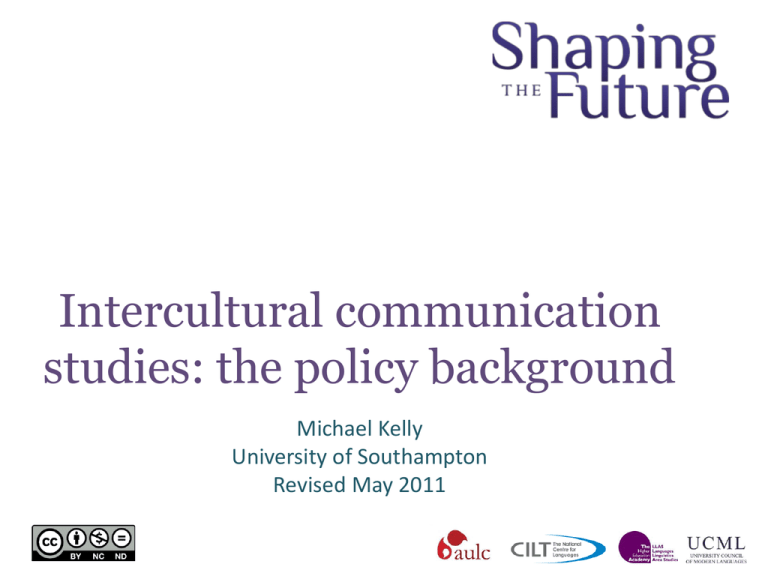
Intercultural communication studies: the policy background Michael Kelly University of Southampton Revised May 2011 Development of intercultural communication • Main growth in 1990’s • Demand from – Business – Government – International organisations – Students Policy context for ICC • Globalisation – Trade and industry – Mobility and travel – Migration, diasporas – Knowledge society – Strategic role of higher education European context • Economic integration • Single Market 1993 • Free movement of: – Capital – Workers – Goods – Services – (information, Ideas) European context • Political integration – Enlargement – Ever closer union – Political cooperation – Citizenship – Social inclusion European context • Cultural integration – Unity in diversity – Shared cultural heritage – Developing cultural cooperation – Convergence in Higher Education Language context • The problem of linguistic diversity – Non-tariff barrier to mobility – Competitive disadvantage in knowledge economy – Mechanism of social exclusion – Cultural barrier to cooperation and mutual understanding Language context • The solution of language education If we are to derive more benefit from free movement within the single market, become more competitive in the knowledge economy and understand and be more aware of each other within an enlarged EU, we Europeans must make an effort to learn languages. (Viviane Reding, European Commission, 2003) • The Barcelona objective: 1 + 2 – Mother tongue plus two other languages Language context • The challenge of multilingualism – High level of competence needed – Diversity exceeds capability – English as international language – Language is more than communication – Communication is more than language The solution of intercultural communication education • Supplement to multilingual communication • Supplement to lack of multilingual communication • But there are issues… Issues in intercultural communication • Cognitive response of research and development community: – Construct ICC from existing disciplines – No single discipline dominates – ‘Bricolage’ (Claude Levi-Strauss) Issues in intercultural communication • Connected with different policy areas, including, for example: – Business – Immigration – Citizenship – Culture Issues in intercultural communication • Business – ICC education for management of cultural diversity • Disciplines – Economics – Management theory – Psychology – Sociology – Area studies Issues in intercultural communication • Immigration – ICC education for community development • Disciplines – Sociology – Social work studies – Anthropology, ethnology Issues in intercultural communication • Citizenship – ICC education for civic responsibility and international understanding • Disciplines – Political science and political philosophy – Ethics – History – Geography Issues in intercultural communication • Culture – ICC education for cultural diversity and enrichment • Disciplines – Literary and cultural studies – Creative and performing arts – History and archaeology – Language and linguistics – Communication studies – Critical theory Issues in intercultural communication • Strengths and weaknesses of Bricolage – High level of adaptability – Difficulties of coherence – Pragmatic, solution-oriented – Limited cognitive power Issues in intercultural communication • Disciplines offer many different theoretical approaches • Approaches may disregard or emphasise: – Language – Culture – Power – National identity Issues in intercultural communication • Different theoretical approaches related to different countries or areas – European – American – Post-colonial • Issue of cultural domination • Issue of national identity • Binary oppositions Third Space approaches to intercultural communication • The Third Space as an alternative – Homi Bhaba • Cultures are not unitary • Meaning requires a third space – Between the self and the other – Between the signifier and the signified Third Space approaches to intercultural communication • Third space formed by: – General conditions of intelligibility • Structure of language, communication – Specific implication of utterance/action • Non-conscious strategy of performance, institution Third Space approaches to intercultural communication • Constructing the Third Space – Pierre Bourdieu • Interactions are constructed – Within a social context of relationships • Which is a coherent field – By participants (agents) • Each has their own habitus Third Space approaches to intercultural communication • Each interaction or set of interactions – Modifies the habitus of participants – Modifies the field • It may reinforce or transform existing relationships • It may create new relationships Third Space approaches to intercultural communication • Third Space approaches are deeply ambivalent • Potentially radical or conservative – Acknowledge power relations • Unmasking or confirming – Strategies of resistance to domination • But also strategies of domination, and resitance to resistance Third Space approaches to intercultural communication • Opportunities for creativity in communication – But also opportunities for further codification and regulation • Opportunities for criticial reflection – But may also be alternative to active engagement Implications for language education • Disadvantages of Third Space approaches – Challenge existing approaches • National cultural perspectives • Target language pedagogies – Demand innovation from educators – Adds to disciplinary variety Implications for language education • Advantages of Third Space approaches – Provide a theoretical framework with cognative power – Draw together (some) different disciplinary approaches – Attract researchers and educators from a range of backgrounds Implications for language education • Improve academic recognition of ICC • Pose radical questions without imposing radical solutions • Potential for innovative solutions • Attractive to policy makers • Connect with a range of pedagogical strategies Implications for language education • Pedagogy of the Third Space • Draws on existing work in language education – Common European Framework of Reference • Council of Europe – Concept of Intercultural communicative competence • Michael Byram and Geneviève Zarate Implications for language education • Four dimensions of skill and knowledge: – – – – Being (savoir-être) - ability to understand and deal with cultural differences without ethnocentricity; Learning (savoir-apprendre) - ability to learn how others live, think, feel and communicate; Knowing (savoirs) - knowledge of aspects of a culture, beliefs and reference points likely to be familiar to natives; Doing (savoir-faire) - ability to integrate the other three dimensions and interact successfully Implications for language education • Intercultural being – Alison Phipps and Mike Gonzalez • • • • openness to the Other self-confidence more inclusive concept of personal identity willingness to see things in relative perspective Implications for language education • Long-term aims – – – – Situate language learning in broader context Improve mutual understanding Promote respect for difference Develop capacity to enjoy diversity
